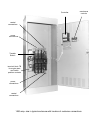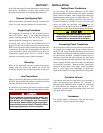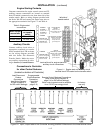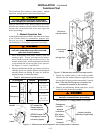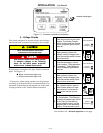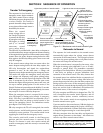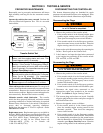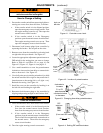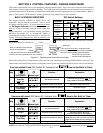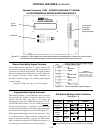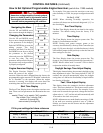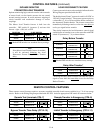
SECTION 3 TESTING & SERVICE
3 --- 1
PREVENTIVE MAINTENANCE
Reasonable care in preventive maintenance will insure
high reliability and long life for the automatic transfer
switch.
Operate the switch at least once a month.Performthis
four step Electrical Operation Test. This is a test with
load transfer.
Transfer Switch Test
1. Press and hold the door-mounted Transfer Test
button until the engine starts and runs. This
should happen w ithin 15 seconds.
2. The transfer switch will operate tothe Emergency
position. I f the Transfer To E mer g ency Delay is
used, the transfer w ill occur after a time delay
(up to 5 minutes). For immediate t ransfer press
Bypas s Ti me Delay button.
3. The Transfer Switch w ill operate back to the
Normal position after the Retrans fer To Nor mal
Delay (up to 30 minutes). For immediate
retransfer press Bypas s Tim e Delay button.
4. Unloaded Running (Engine Cooldown) Delay
allows engine to run unloaded for 5 minutes.
Clean andinspect the switch once a year. De-energize all
sources, then brush and vacuum away any excessive dust
accumulation. Remove the transfer switch barriers and
check contact condition. Replace contacts when pitted or
worn excessively. Reinstall the barriers carefully.
Maintain transfer switch lubrication.Thetransfer
switch has been properly lubricated, and under normal
operating conditions no further lubricating is required.
Renew factory lubrication i f the switch is subjected to
severe dust or abnormal operating conditions.
Relubricate the operator if TS coil is replaced. Order
lubrication kit 75-100.
Replacement parts. Replacement parts are available in
kit form. When orderingparts provide the Serial No. and
CatalogNo. from the transferswitchnameplate. Contact
your local ASCO Power Technologies sales office,
representative, or ASI. In the United States call
1–800–800–ASCO (2726), or in Canada call
1–888–234–ASCO (2726).
DISCONNECTING THE CONTROLLER
The harness disconnect plugs are furnished for repair
purposes only and should not have to be unplugg ed. If the
controller must be isolated, follow these steps carefully.
Disconnecting the Plugs
Do not unplug the controller until step
1a. or 1b. below is completed.
1. Observe the position of the transfer switch.
a. If the transfer s w itch is in the Normal position, place
stand b y engine s tar ting contr ol in the off position.
Then open the emergency source circuit breaker.
b. If the transfer switch is i n the Emergency position,
open the normal source circuit breaker. Place the
engine starting control in the test or run position.
2. Separate the quick disconnect plugs bysqueezing the
latches. Do not pull on the harness wires.
3. Label, remove, and tape the signal wires connected
to the engine start terminals on the transfer switch:
TB1 and TB3, or TB1 and TB2.
Reconnecting the Plugs
Do not reconnect the controll er until step
1a. or 1b. and 2 below are completed.
1. Observe the position of the transfer switch.
a. If the transfer switch is in the Normal position, be
sure that the standby engine starting control is still
in the off position. The emergency source circuit
breaker still should be open.
b. If the transfer switch is i n the Emergency position,
normal source circuit breaker still should be open.
2. Reconnect the signal wires connected to the
appropriate engine start terminals on the transfer
switch. See Section 1, Engine Starting Contacts.
3. The harness plugs and sockets a re keyed. Carefully
align the plugs with the sockets and press straight in
until both latches click.
4. Restore the opposit e source as follows:
a. If the t ransfer switch is in the Normal position,
place the standby engine starting control in the
automatic position. Then close the emergency
source circuit breaker.
b. If the t ran sfer sw itc h is in th e Emergency position,
close the normal source circuit breaker. The load will
be automatically retransferred to the normal source
after the Retransf er to N o rm a l Delay. F or immediate
retransfer, press Bypass Time Delay button. Place the
engine starting control in the automatic position.




